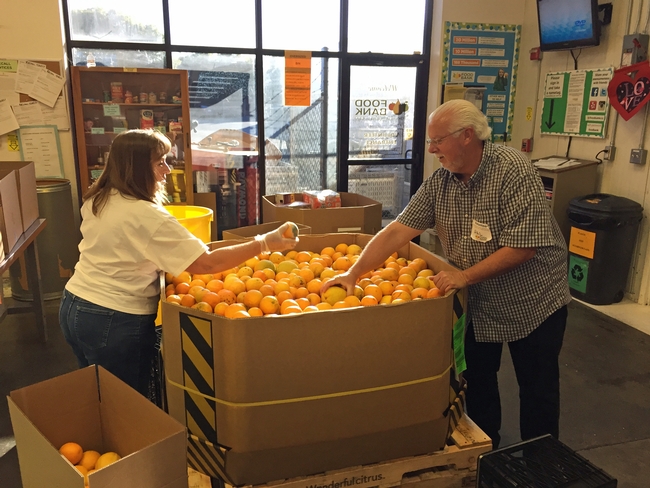Posts Tagged: Cassandra Nguyen
Fewer than 10% of patients screened for food insecurity during pandemic
Study finds even fewer screened during virtual appointments
As jobless rates rose during the COVID-19 pandemic, millions more Americans experienced food insecurity because they lacked consistent access to food. National health organizations recommend primary care providers screen patients for food insecurity, since not having access to enough food can lead to chronic diseases.
But research from the University of California, Davis, finds that only 7% of primary care providers screened patients for food insecurity. If the appointment was virtual or telehealth, only 3% asked patients about their access to food. The American Journal of Preventive Medicine published the research.
“These rates are surprising and seem relatively small in comparison with what seems like a growing awareness of food insecurity during the pandemic,” said lead author Cassandra Nguyen, an assistant professor of Cooperative Extension in the UC Davis Department of Nutrition.
She said the findings may indicate that health care providers were prioritizing emergency responses to COVID-19. The research showed that once people had access to COVID-19 vaccines, screening for food insecurity increased to 10%.
Barriers to telehealth screenings
Screening for food insecurity at telehealth appointments remained low even after vaccines became available. Nguyen said that may suggest telehealth appointments have unique barriers.
“One of those barriers could be a concern about privacy and whether the patient is alone or feels comfortable discussing a potentially stigmatizing experience such as food insecurity. This may deter a primary care provider from asking about it,” Nguyen said.
Screening might also be more difficult if patients aren't familiar with the technology needed or if there are technological disruptions during telehealth appointments. Nguyen said more study is needed about potential barriers given the increased popularity of telehealth appointments since the pandemic.
The research examined electronic health records and clinic data from a national network of more than 400 community health centers in 16 states. It examined encounters between March 11, 2020, and Dec. 31, 2021. Screening typically involves a primary care provider asking the patient to answer that either or both of the following two statements is often true or sometimes true:
- Within the past 12 months we worried whether our food would run out before we got money to buy more.
- Within the past 12 months the food we bought just didn't last and we didn't have money to get more.
Co-authors include Rachel Gold with OCHIN Inc. and Kaiser Permanente Northwest Center for Health Research; Alaa Mohammad, Dedra Buchwald and Clemma Muller with Washington State University; Molly Krancari, Megan Hoopes and Suzanne Morrissey with OCHIN Inc.
The National Center for Advancing Translational Sciences of the National Institutes of Health, and the National Institute of Diabetes and Digestive and Kidney Diseases supported the research.
Can food banks better promote nutrition and health?
New tool helps assess policies and practices
An estimated 53 million people in the U.S. turned to food banks and community programs for help putting food on the table in 2021. In recent decades, food banks have adopted policies and practices to make sure people not only have access to food but also healthy and nutritious food.
But until now, food banks have had few ways to evaluate those initiatives.
University of California, Davis, Assistant Professor of Cooperative Extension Cassandra Nguyen led a team of researchers to develop the Food Bank Health and Nutrition Assessment to address that concern. Their findings were published in the journal Public Health Nutrition.
“This tool will allow food banks to reflect on their current practices and determine whether they can adopt additional strategies to promote nutrition and health. It also serves as a benchmark, which they can use to track their progress over time,” said Nguyen, with the UC Davis Department of Nutrition.
Nutrition policy is more than what's on the shelf
Food banks face some common challenges in promoting nutrition, health and equity. While food banks could assess the nutritional quality of their inventory, Nguyen said promoting nutrition requires more than knowing the types of food on the shelf.
“Food banks can have nutrition policies that outline where they source food and which foods they prioritize when funding is available. They can also ensure that food pantry clients are either represented on advisory boards or are able to provide feedback about foods they would like to receive,” Nguyen said.
Additionally, food banks can take steps to make sure nutrition education materials and information about federal assistance programs for health and nutrition are available in languages spoken by recipients.
Partnerships with outside organizations and local farmers can also increase the variety and availability of nutritious foods. Food banks with diverse connections may also adapt better to unexpected spikes in need, such as during the COVID-19 pandemic.
The Food Bank Health and Nutrition Assessment was designed to evaluate these and additional objectives so food banks can identify areas of success as well as potential strategies they hadn't considered before.
Importance of data
“By having data from this assessment to show that some practices to promote nutrition and health may be difficult to implement, several food banks can raise their voices to advocate for policy changes,” Nguyen said.
Food banks with Feeding America and the Midwest Food Bank in four Midwestern states participated in the initial development of the Food Bank Health and Nutrition Assessment. In this small initial sample, most food banks asked food recipients about their preferences or whether diet-related diseases (for example, diabetes) were common, but few had current or former charitable food recipients on advisory boards.
The assessment is available for free through Feeding America, the largest nonprofit organization supporting the charitable food system, and online through the University of Illinois Extension. Food bank staff and partnering community-based professionals such as extension staff can use the assessment to improve promotion of nutrition and health.
Other authors include Caitlin Kownacki, Veronica Skaradzinski, Kaitlyn Streitmatter, Stephanie Acevedo and Jennifer McCaffrey with the University of Illinois at Urbana-Champaign; Stephen D. Ericson with Feeding Illinois; and Jessica E. Hager with Feeding America.
Funding for the research was supported by the Supplemental Nutrition Assistance Program-Education, or SNAP-Ed, in Illinois


